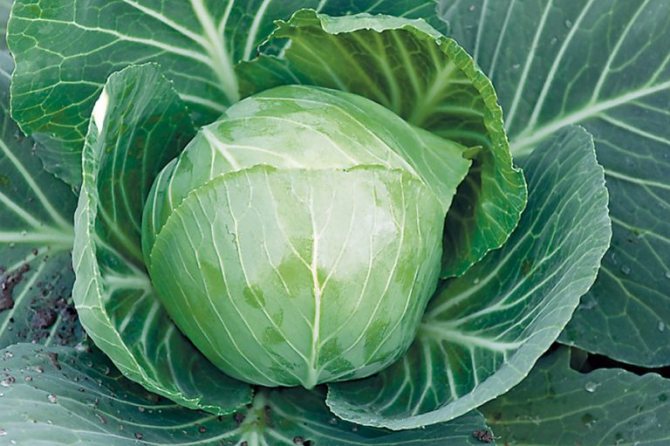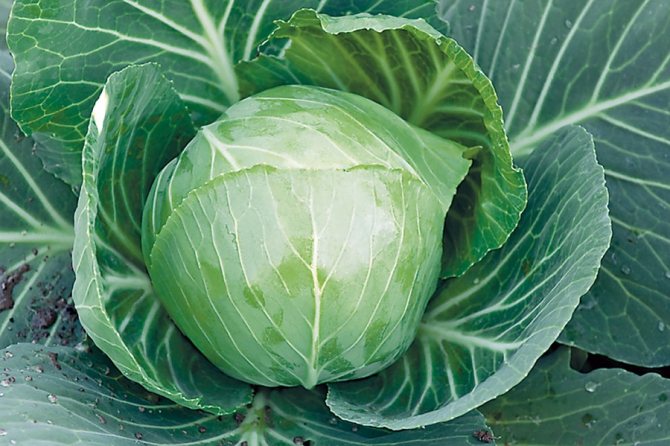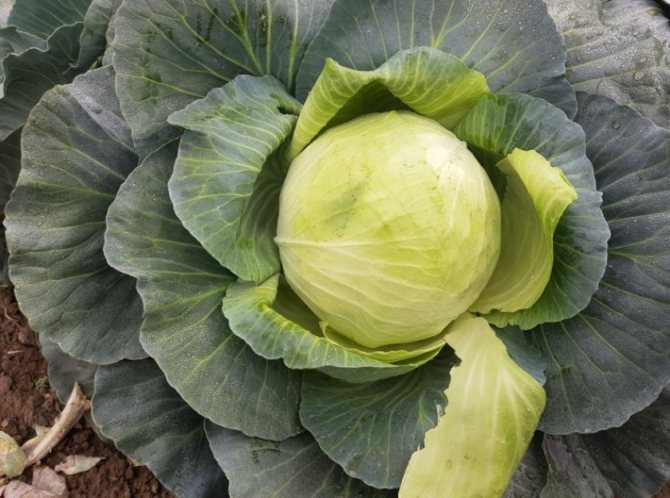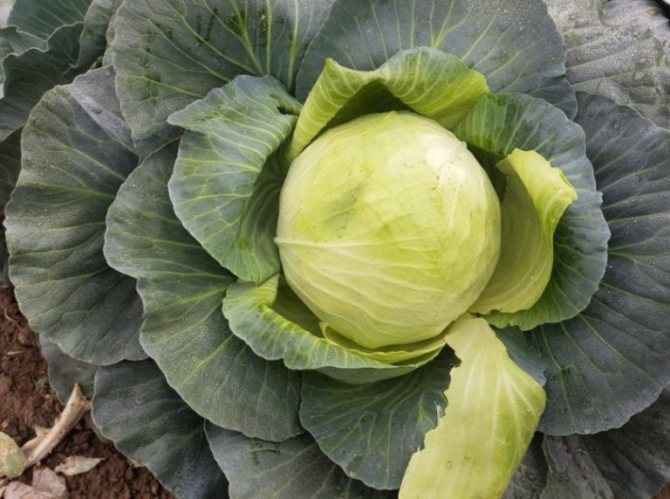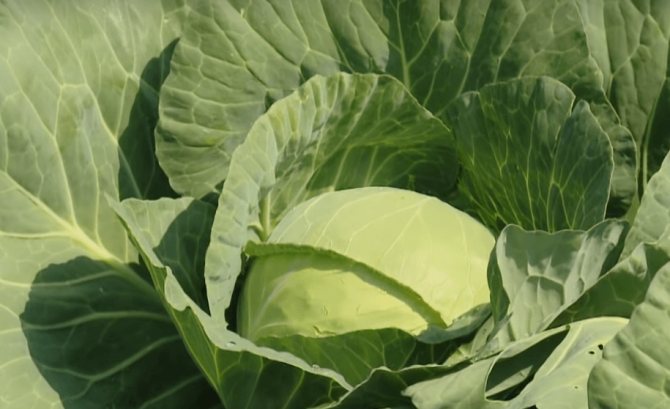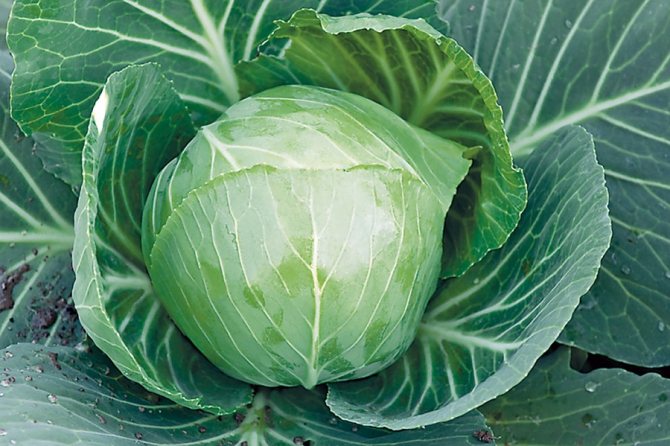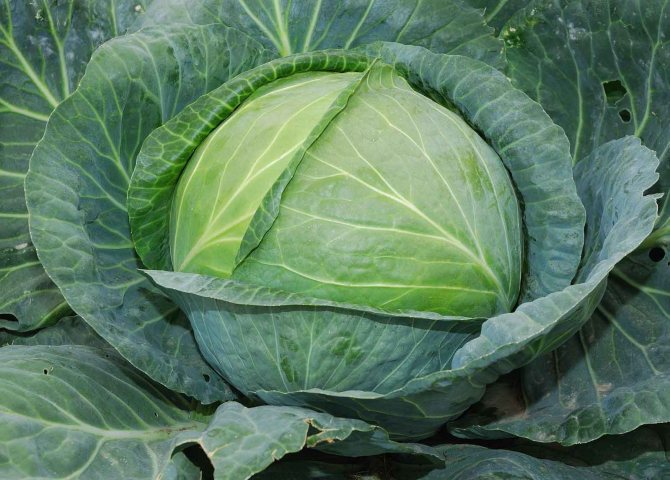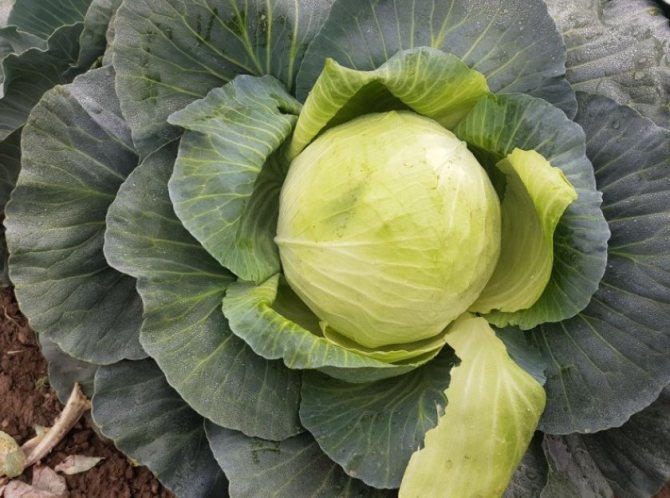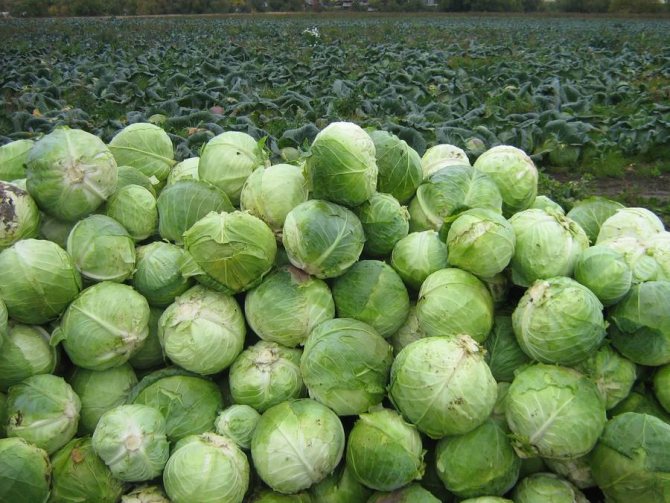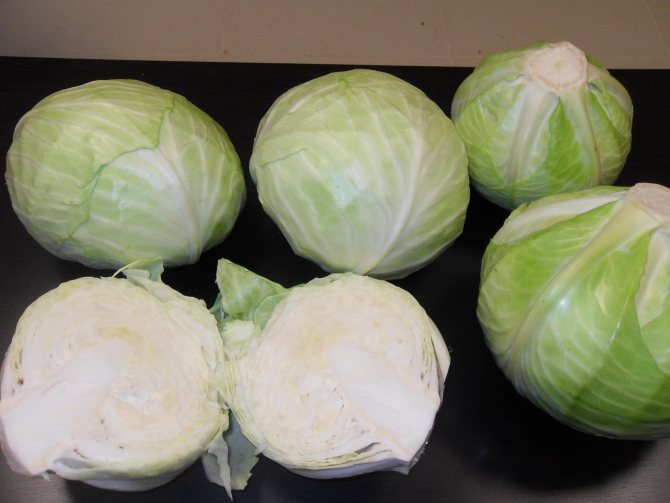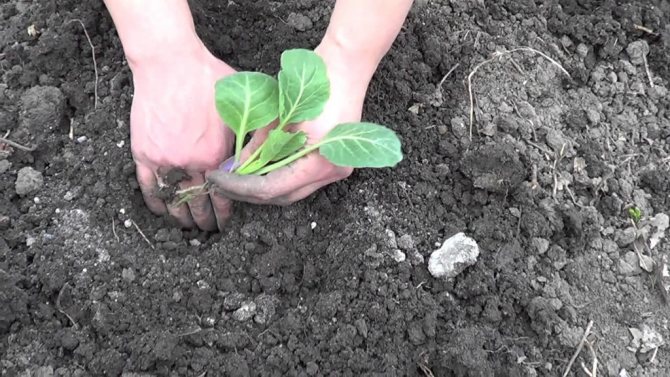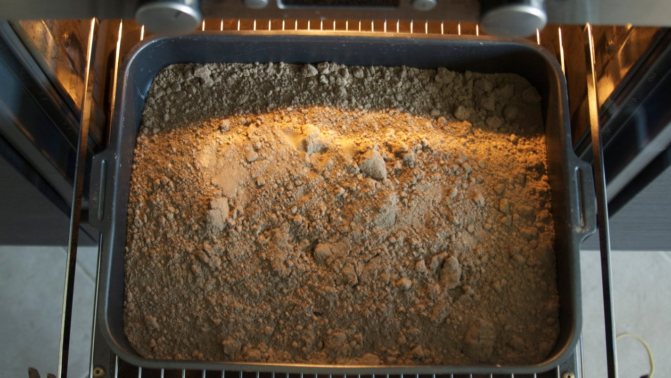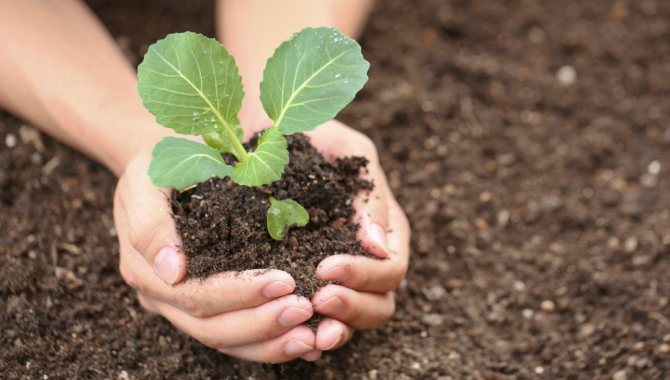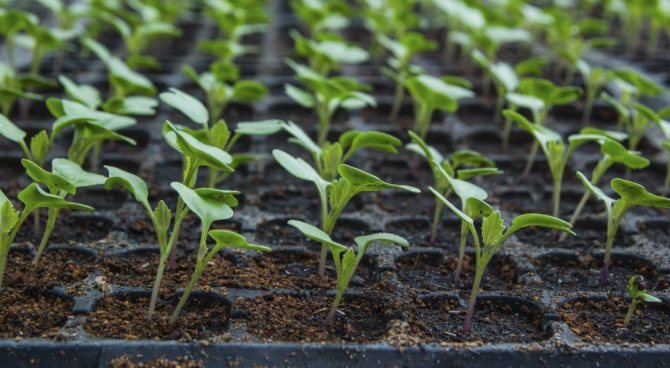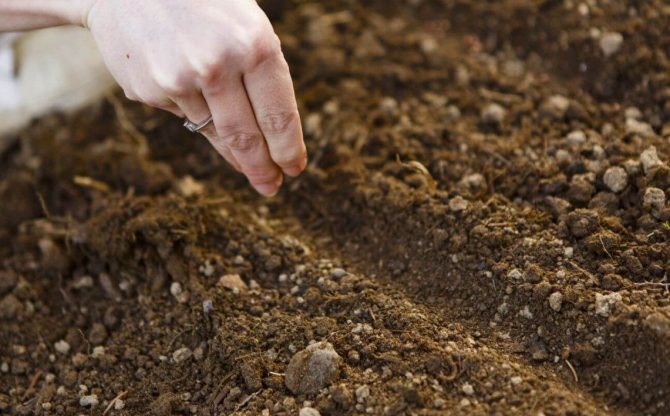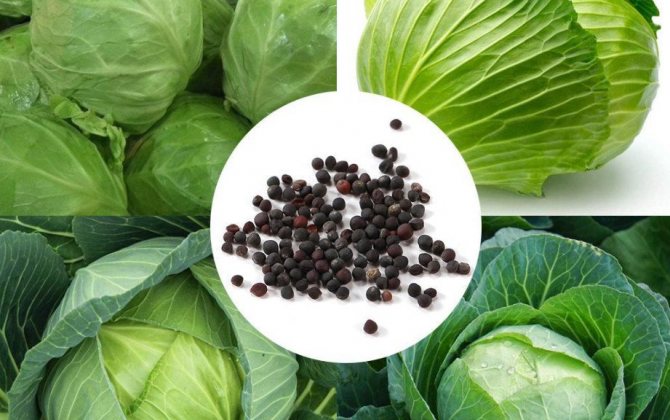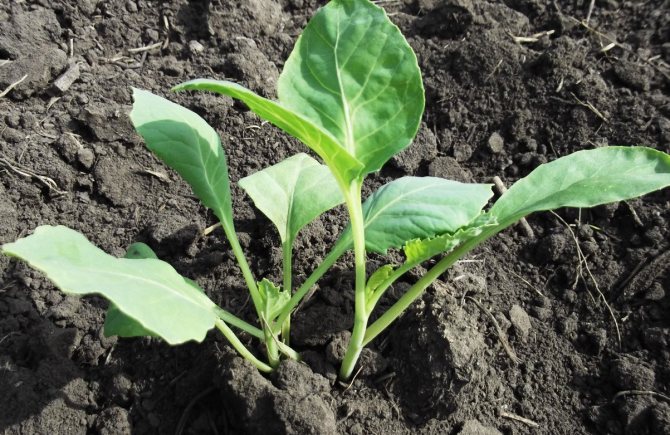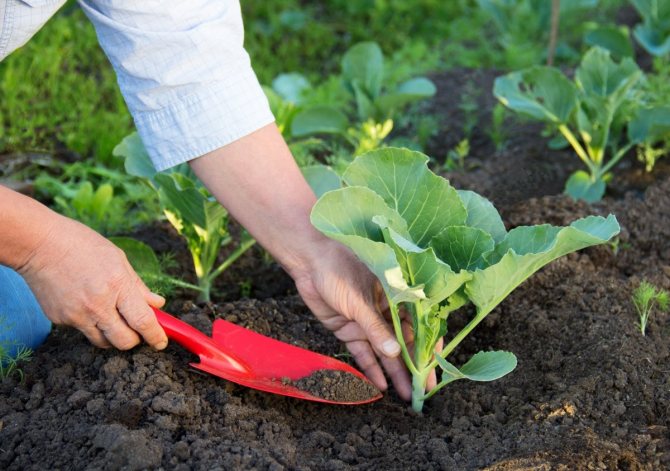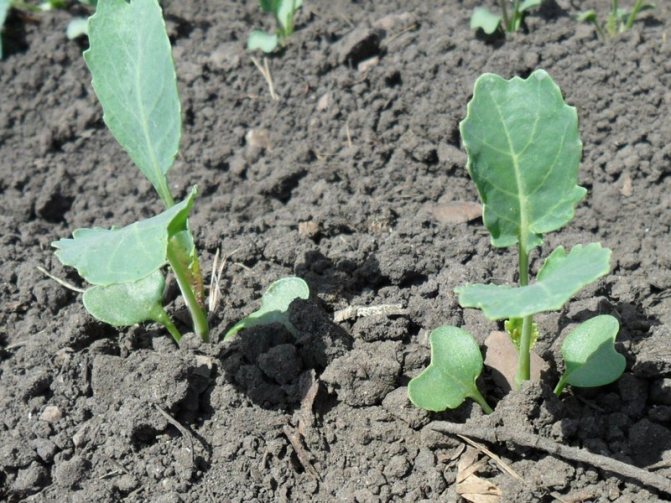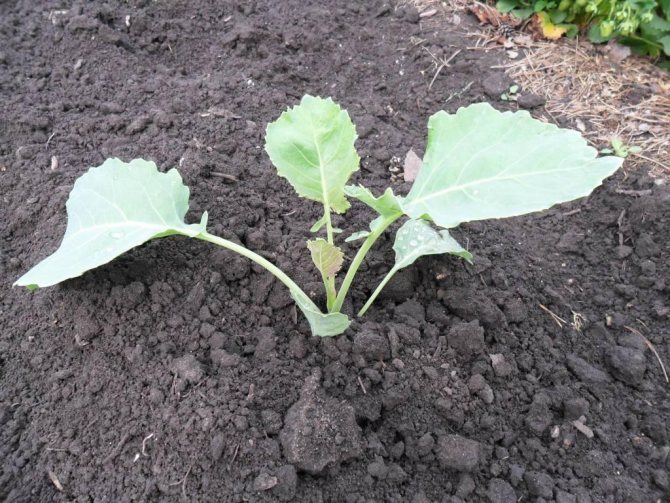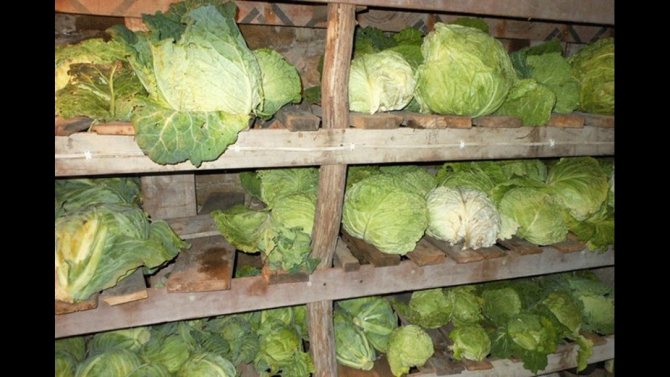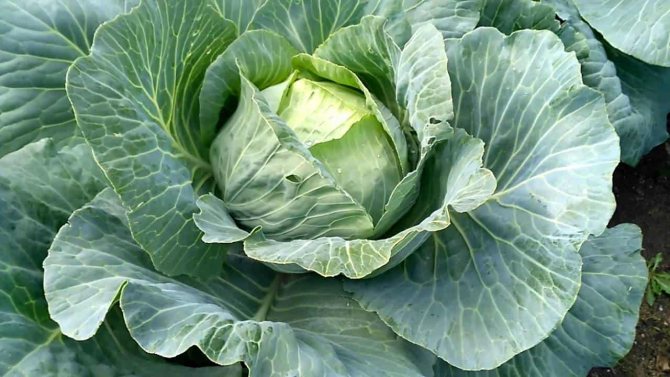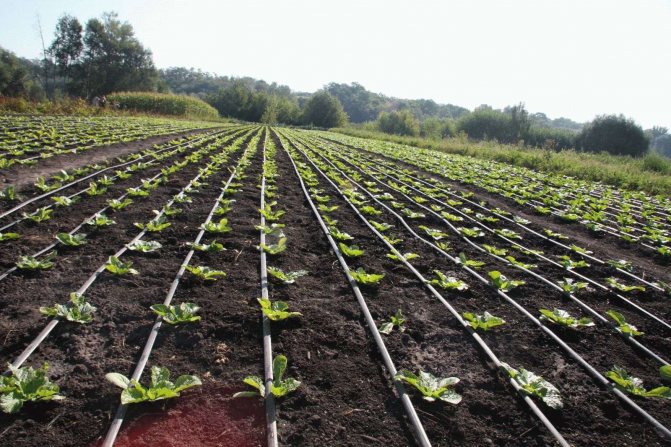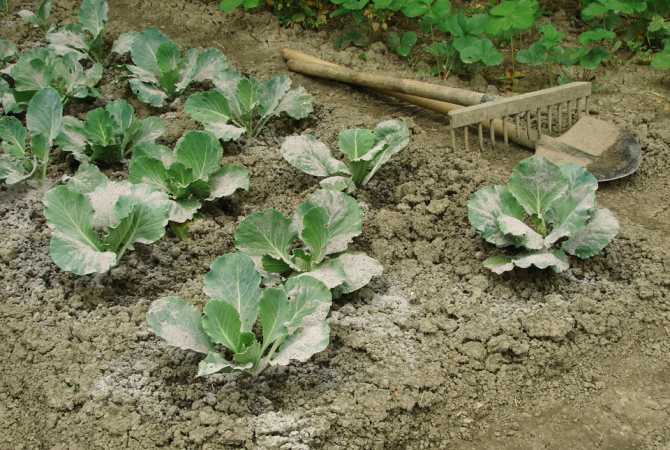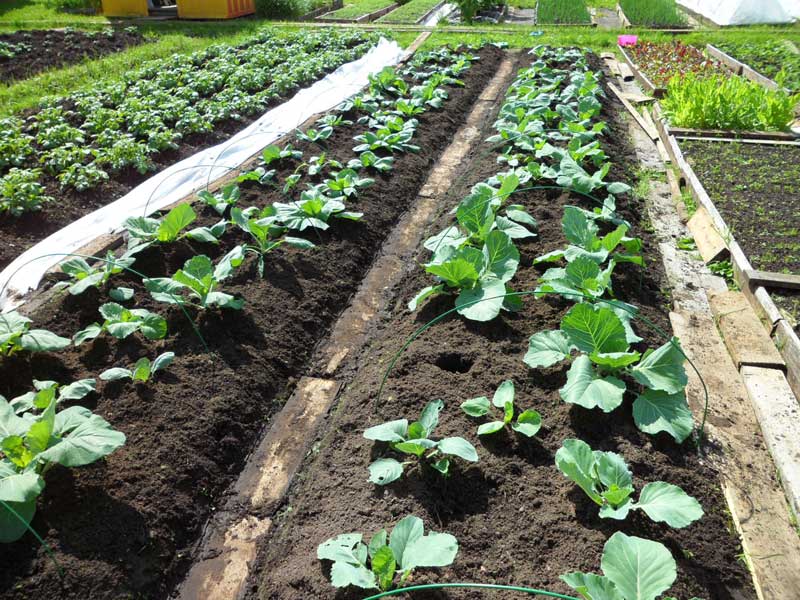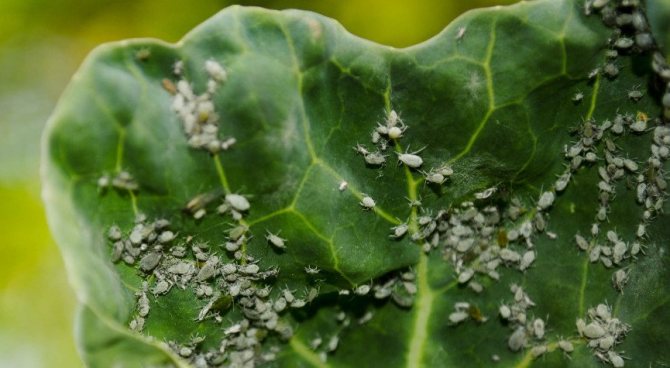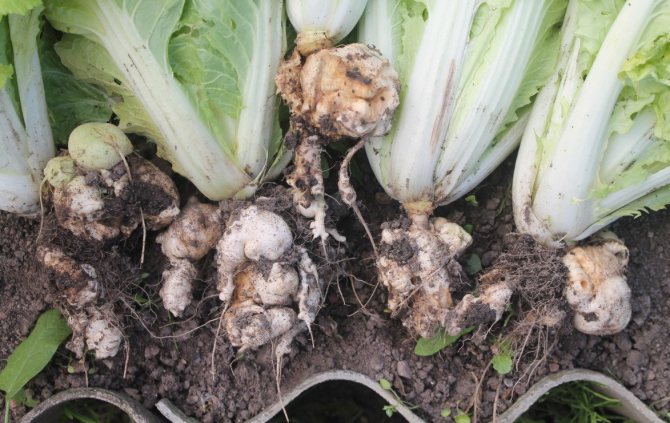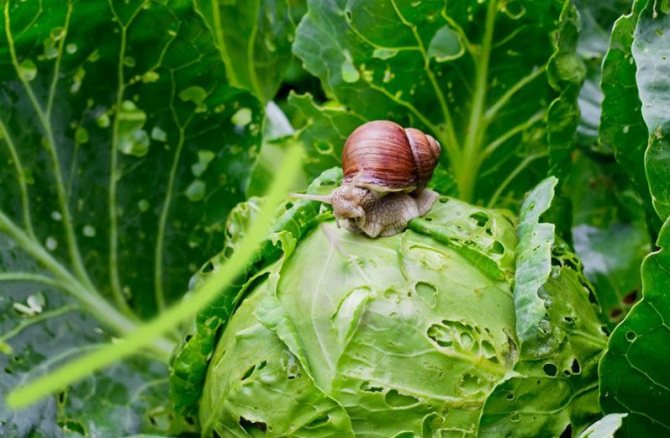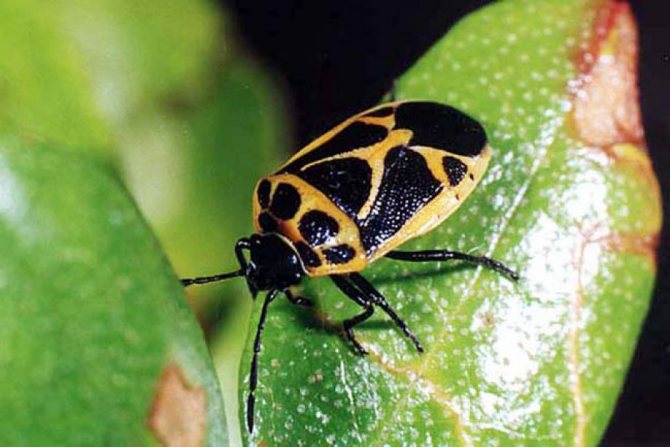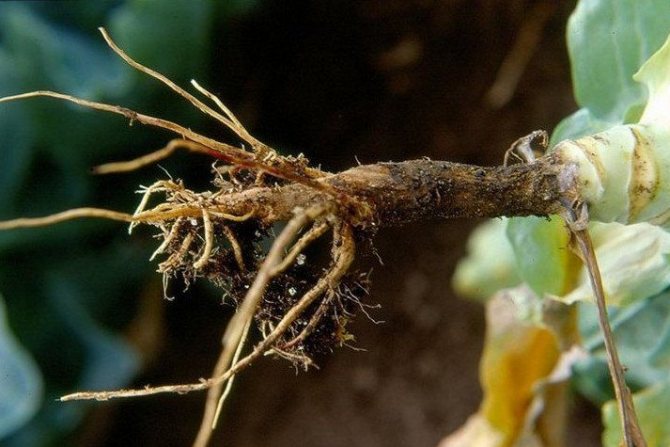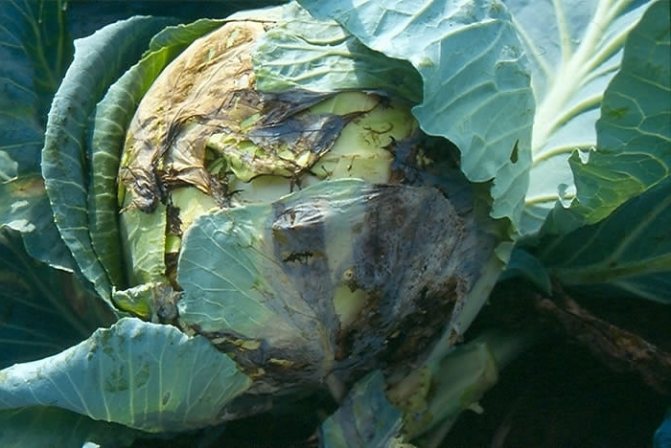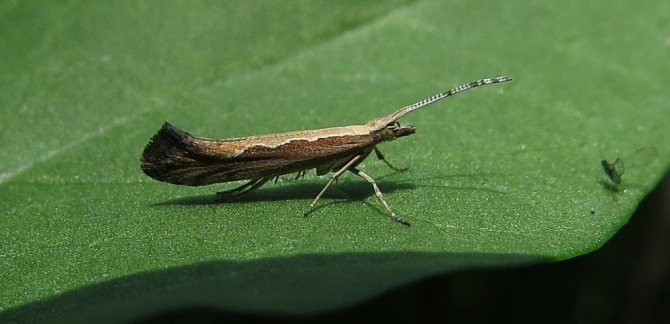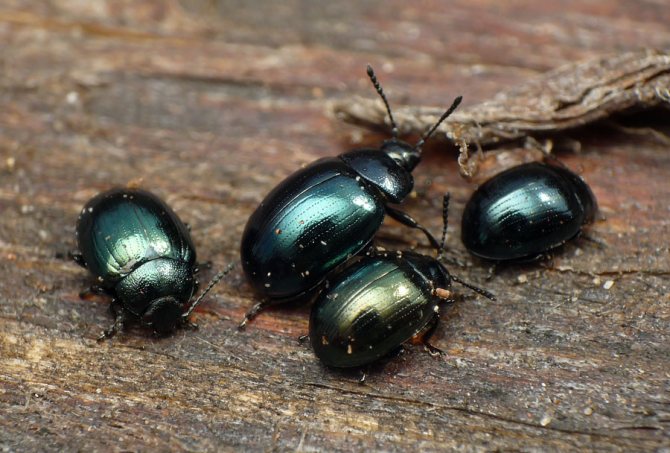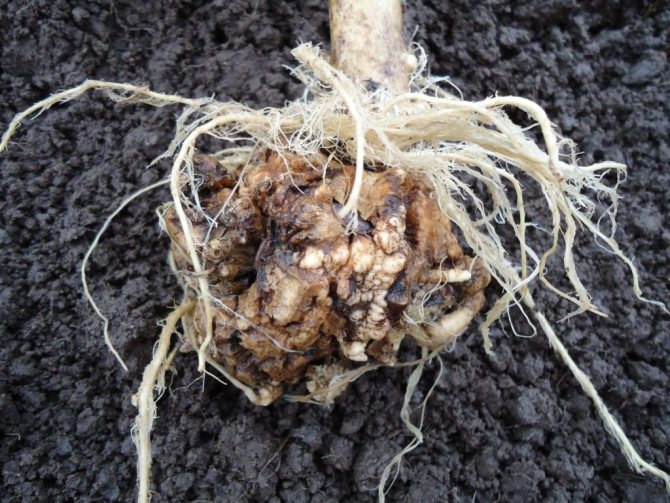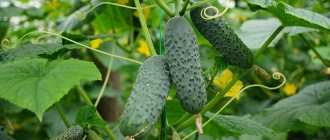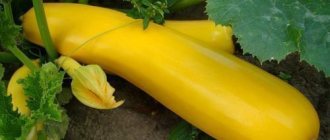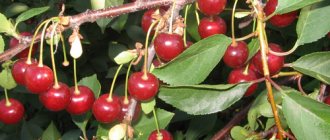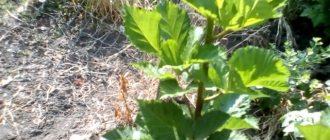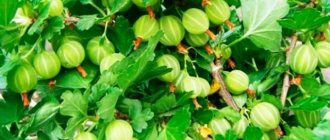
White cabbage is an amazing vegetable. Its health benefits are obvious, it is rich in vitamins A, B1, B6, P, K, U, nutritious, tasty and low in calories. And it is also known for the fact that heads of state, politicians, generals and poets were fond of its cultivation. Cultivation of culture was considered an aristocratic occupation! The ancient Roman emperor Gaius Aurelius Valerius Diocletian relinquished power to develop new varieties. History is silent about what he did, but he would have liked the Aggressor cabbage, the description of which you will read below.
- Pros and cons of a hybrid
- Landing features
Seedless way
- Growing cabbage by seedling method
- Fertilization - table
- Pest control - table
- Storage methods
Description and characteristics of the variety
White cabbage Aggressor F1 is a hybrid of the first generation. It was created in 2003 by specialists from the famous company Syngenta Seeds from Holland, which owns many resistant and productive hybrids. Then it was entered into the Russian State Register. Cabbage can be grown outdoors in the northern regions and further south - in Moscow, Smolensk, Ryazan, Tula, Bryansk, Vladimir and other regions.
Variety Aggressor F1 perfectly tolerates temperature extremes, cold snaps, rains, droughts, lack of nutrients in the soil. This does not prevent it from forming forks.
From planting to collecting the heads, 115-120 days pass, the hybrid is medium-late.
The minimum weight of a head of cabbage is 3 kg, the maximum is 5, but there are specimens weighing up to 6 kg. Heads of cabbage are round, slightly flattened, with dark green upper leaves, white or yellowish in section. There is a waxy coating on the outer leaves, they are slightly wavy, can be bent outward. The length of the stalk is 16-18 cm, the roots are powerful.
Taste qualities
The pulp is crispy, juicy, with a pronounced pleasant aroma. Contains 5.6% sugar and 9.2% dry matter. Heads of cabbage are not prone to cracking. They are used to:
- long-term storage (in a dark cool place they lie for 5-6 months, or until April);
- preparation of any dishes;
- salting;
- fermentation;
- fresh.
Gardeners reviews
When I was still working on cabbage, the Aggressor hybrid passed. A strong variety, it develops well, produces high quality beautiful heads of cabbage, but the leaf is coarse, the taste is close to mediocre.
Amplex
Sowed 2 hybrids of late-ripening white cabbage: Aggressor F1 and Kilaton F1. Planted at the end of the third decade of May, the predecessor - tomatoes for 2 years in a row. Aressor is very good, versatile, tasty, also very good for fermentation. But she lay in the basement only until mid-March. And then the heads of cabbage began to crack and sprout.
Vladimir Starchenko
Last year, the aggressor bought cabbage seeds of Russian selection, the summer was hot, we did not have a single rain in July-August, all the varieties of cabbage that I planted (turkis, glory, stone head) were small, I threw something out altogether.And the aggressor lived up to its name, heads up to 5-6 kg, dense, white inside. Fermented, it turned out delicious and juice in moderation. And it still lies well. I was at an exhibition in the planetarium and again bought the seeds of this cabbage. Buy, you will not regret it.
Pear
A number of advantages possessed by the Aggressor variety greatly facilitate the cultivation of a vegetable. Cabbage was recently bred, but has already proven itself on the positive side. The variety also has the disadvantage that it is not resistant to certain diseases. But timely preventive measures will help protect the crop.
Hello! Let's get to know each other, my name is Yana, a foreign economic activity manager by education. Rate the article:
- 5
- 4
- 3
- 2
- 1
(4 votes, average: 4.8 out of 5)
Share with your friends!
Advantages and disadvantages
Pros:
- excellent taste and marketability;
- high productivity;
- the ability to tie forks in all weather conditions and even on poor soils;
- immunity to major diseases;
- undemanding to care and feeding;
- the ability to sow seeds directly into open ground;
- heads of cabbage do not crack;
- seed germination rate - almost 100%;
- long-term storage throughout the winter.
Minuses:
- if the leaves are yellowish, when fermented, they can taste bitter;
- sometimes suffers from fungal diseases.
Pros and cons of a hybrid
| Benefits | disadvantages |
| Produces a high yield, even under unfavorable conditions. | May be affected by aphids and whiteflies. |
| Grows successfully on depleted soils, unpretentious. | There is no immunity to the fungal disease - keela. |
| It tolerates drought well, undemanding to watering and care. | Sometimes the leaves are harsh; when salted, they acquire a bitter taste. |
| 100% of seeds emerge. | |
| There is immunity to thrips, fusarium wilting and punctate necrosis. | |
| Resistant to most pests. | |
| Gives heads of cabbage presentation, easy to transport. | |
| Stores well for 5-6 months. | |
| The taste is pleasant, it is used fresh and fermented. |
Landing technology
This cabbage can be planted both as seedlings and directly into the ground. The seedling method shortens the ripening time.
Seedless growing method
In the fall, they prepare a garden bed in a sunny place, protected from drafts. The optimal predecessors are legumes, nightshades (tomato, potato, pepper) and pumpkin (cucumbers, zucchini, pumpkin). Unsuitable predecessors - other cruciferous (turnip, radish, radish).
The garden bed is dug up, fertilized with organic matter and wood ash, then mulched and covered with foil. Seeds are sown when the snow melts and the threat of frost disappears, usually at the end of April.
2-3 seeds are placed in one hole about a centimeter deep. Arranged according to the scheme 60 to 70. After germination, thin out, leaving one strongest plant. They are carefully watered, weeds are weeded, and fed.
Seedling method of growing
For seedlings, soil is made from humus, sand and peat in equal shares, or they are purchased ready-made. A self-prepared substrate is disinfected with a solution of potassium permanganate, freezing in a freezer or calcining in an oven.
Seeds are sown in separate pots or cups of 2-3 pieces. Sowing depth - 1 cm. When sprouts appear, they are thinned out and kept at a temperature of + 15-18 degrees and good lighting.
They are fed 2-3 times with special fertilizers for seedlings or weak solutions of nitrogen or organic fertilizers. They are hardened before transplanting into open ground.
The term for growing seedlings indoors is 35-40 days.
Features of agricultural technology
Seedless growing method
The term for sowing cabbage Aggressor F1 seeds is the end of April - the first half of May, depending on the region (up to the beginning of June). The planting scheme is about 50 by 70 cm, in holes about 0.5-1 cm deep. Two seeds are placed in one hole (then the best sprouts are left or they are planted).The buried seeds are moistened with a spray bottle, sprinkled with soil and irrigated again.
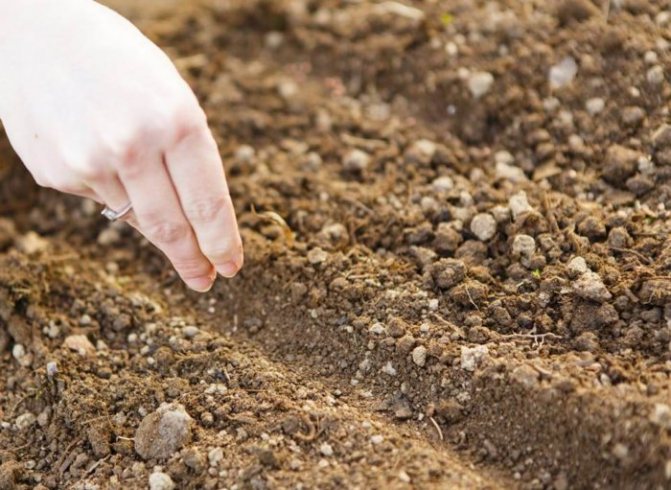

Sowing cabbage seeds Aggressor F1
In the first days after planting over the beds, a film is pulled on pegs, preferably black. Make sure that the soil under the film is moist, but not overflowed. After the emergence of seedlings, the film must be removed. If the nights are cool, with frost, for some time you can cover young shoots at night with insulation, for example, spunbond.
Growing seedlings from seeds
For seedlings, the variety in most regions needs to be sown in early April - if planting is carried out in open ground, in pots or containers. Depending on climatic and weather conditions, the period can be shifted - at the rate of 35-50 days before planting in the ground.
The recommended temperature is 18 degrees Celsius. It is necessary to provide good illumination from all sides. The seedlings must be hardened - they must be taken out on the balcony or outside during the day so that they do not stretch out and endure the transplant well. Water sparingly in order to exclude the development of fungus in the soil.
Preparing the beds
The land can be cultivated in the fall (this is better), or in the spring. Dig up the soil, remove tops, weeds, root crops, spill with a disinfecting solution, add bottom peat, compost or humus (5-6 kg / sq. M). If the main preparation took place in the fall, we re-dig the soil in the spring. It is permissible to split channels (ditches).
Open ground transplant
After 35-50 days, seedlings can be planted in moist, fertilized soil in the same way as seeds. We plant sprouts, deepening to the first true leaf. The first time we cover at night, if it's cold.
Important! Do not plant cabbage in places where cruciferous crops were in the previous three years: radish, turnip, cabbage, radish. It is good to use the area after potatoes, legumes, tomatoes, cucumbers, zucchini, onions. The Aggressor does not like acidic soils. Choose areas with good lighting and air movement.
Cabbage Care Aggressor
The variety loves abundant and frequent watering - at first every two to three days, after the seedlings have rooted - on average once every five days (according to the condition of the soil). At the same time, the soil cannot be poured. Prefer warm water for irrigation and the most useful, morning or evening hours. Avoid getting water on the plants themselves.
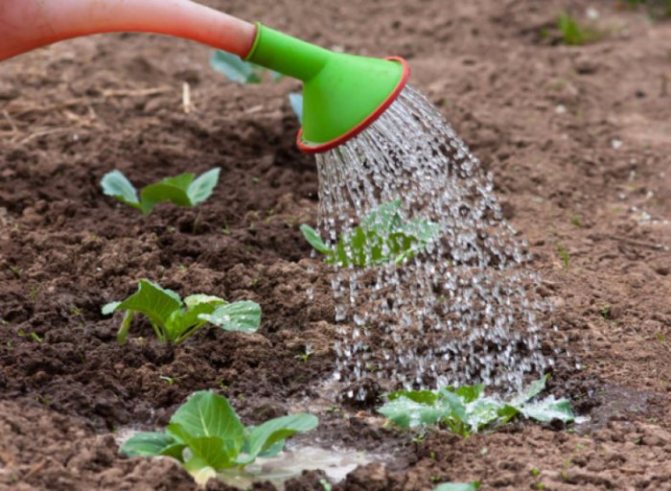

Watering cabbage
Two to three weeks before harvesting the heads of cabbage, watering should be stopped, as the heads of cabbage are poured, it should be minimized.
Canal (ditch) and, even better, drip systems will facilitate the task of irrigation.
Attention! Mulching can increase the interval between waterings and slow weed growth. But there is a risk of slugs, as well as the development of fungi.
As the weeds grow, you need to weed, after each watering - loosen the soil. The plants are piled up for the first time after the seedlings have begun - we cover with earth only a part to the first true leaf! If you carry out the second hilling, remove the lower leaves first.
Although the manufacturer claims that the variety does not need nitrogen fertilization, it will not hurt to apply fertilizers periodically. When preparing the ground, it can be superphosphate (20-30 g / sq. M), urea (30-40 g / sq. M).
To protect cabbage from pests and diseases, you can spray it with a safe soap-ash solution. It is useful to plant odorous marigolds, cilantro, mint next to cabbage - their aroma will scare off harmful insects.
Harvest
Depending on the planting time, cabbage is harvested at the end of September - October. The heads of cabbage should be firm and poured.
The ideal time for cleaning is dry, clear weather with a daytime air temperature of 4-7 degrees Celsius.
Important! If the heads of cabbage are not separated from the roots, the plants will withstand frosts down to -7 degrees. When cut, the cabbage will freeze. In such a situation, wait until it thaws and only then process the vegetable. It is impossible to store frozen heads of cabbage without processing.
Before harvesting, it is helpful to remove the lower leaves so that they do not start to rot. If not cut off, leave them together with 3-4 centimeters of stumps, and cut off the heads of cabbage with a knife.
You can also pull it out completely and then cut it off. In any case, remove stumps, roots, leaves from the beds and destroy.
After harvesting, sort the heads of cabbage: the densest can be left for the cellar, and the loose ones can be put on dishes and blanks.
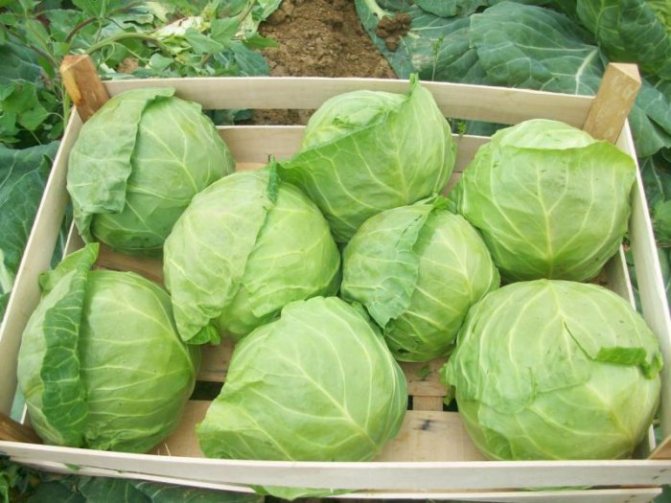

Cabbage harvest
Storage
The characteristics of the Aggressor F1 variety make it possible to keep this cabbage fresh for a very long time - up to six months.
The densest and healthiest heads of cabbage are suitable for storage, without mechanical damage and damage from diseases and pests.
Selected cabbage is not recommended to be stored on the floor, on the ground, especially in a heap. Lay it on shelves, wood flooring with small gaps, stump up. You can also hang the heads of cabbage in pairs by the stumps.
Ideal storage conditions: temperature from minus 1 to plus 2 degrees. Celsius, air humidity - 90-98%. Most often, cellars correspond to such conditions.
Growing and care
Agricultural technology includes watering, fertilizing, loosening the soil and weeding.
The first two weeks after transplantation are watered every 3-4 days. 6-8 liters of water at room temperature are added per square meter. Then they switch to abundant watering once a week (10-12 liters of water).
Watering is stopped three weeks before the collection of the heads, otherwise the cabbage will be poorly stored.
The soil is carefully loosened and weeded, mulch to retain moisture. Hilling plants is useful.
During the growing season, they are fed three times:
- 20 days after transplanting, a 1:20 mullein solution is introduced into the garden;
- repeat after ten days;
- after another three weeks, a mineral fertilizer is applied - a complex with potassium and phosphorus for cabbage or ammofosku (for 10 liters of water - no more than 2 tablespoons of fertilizer, for 1 sq. m about 8 liters of solution).
Harvesting and storage
Harvested in late September - early October in dry weather. The heads of cabbage are carefully cut and kept in a dry and dark place at a temperature of about +5.
Harvesting
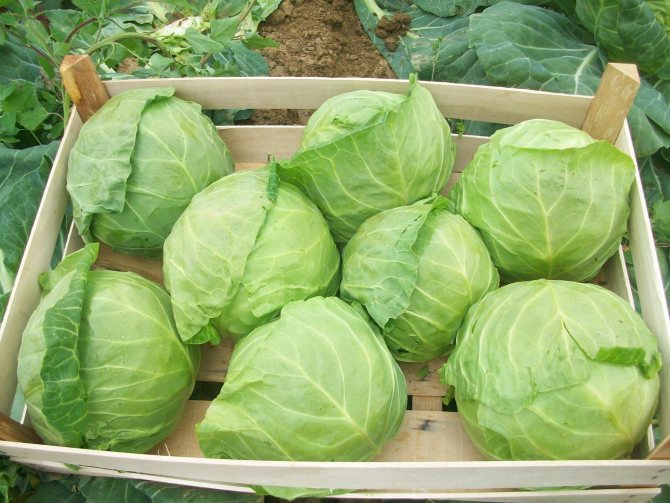

Cabbage is harvested in early autumn.
Since the Aggressor cabbage is a late variety, harvesting begins at the end of September or early October. Cabbage is harvested in dry weather, when the daytime temperature does not exceed +8°C, and at night the indicators do not fall below 0°FROM.
Advice! Prepare a hatchet or sharp knife in advance. This will make harvesting easier.
Ready-to-harvest cabbage can be distinguished by its size and shiny leaves. Using a knife or a hatchet, carefully cut off the heads of cabbage, leaving 3-4 cm of the length of the outer stump with several leaves. During storage, the head of cabbage will consume nutrients from them.
When the entire crop is harvested, you need to do the following:
- Separate from the total mass of cabbage that has mechanical damage or signs of disease. If there are dried leaves on the head of cabbage, they should be removed.
- Place vegetables in 2-3 rows in a cellar or cellar. Another storage option is hanging the heads of cabbage on slats.
Important! The optimum temperature for cabbage is + 1 ° С .. + 5 ° С. The humidity in the room where the heads of cabbage are located should not fall below 90%. Light should be avoided, otherwise the cabbage will sprout.
Heads of cabbage keep well due to their resistance to cracking. The Aggressor variety is widely used for salting, making fresh salads, stewing, canning.
Note! Due to the high content of vitamin C, cabbage is suitable for baby and diet food.
Disease resistance
The hybrid does not suffer from fusarium; it is avoided by some pests, including the cruciferous flea and thrips. However, it can be affected by keela, black leg and peronosporosis.
Keela
It is a fungus that lives in the soil. The affected plant withers, darkens, becomes bluish-green, and the root rot.Affected specimens will have to be destroyed. It is almost impossible to cure the keel; careful prevention is required. The seeds are etched in a Granosan solution, the soil is spilled with a fungicide solution, and the roots of the seedlings are dipped in clay diluted with water before transplanting.
Peronosporosis
It develops more often in greenhouses and affects cabbage with yellow spots and bloom. Treatment - spraying with a solution of Bordeaux liquid (50 ml of the drug is needed for 10 liters of water).
Protecting the Aggressor from Diseases and Pests
It is not recommended to use poisonous chemicals to protect cabbage, it is a food product. But there are also harmless ways.
Pest control - table
| Pests | Description | Signs of defeat | Ways to fight |
| Cabbage moth | The insect is dangerous for cabbage at all stages of development: caterpillar, pupa and yellow-green butterfly. |
|
|
| Cabbage aphid | A tiny insect 2-3 mm in size, it settles in whole colonies. |
| Remove insects from leaves with a cloth soaked in soapy water, milk or whey. |
| Cabbage fly | Small insect (up to 6 mm), gray with transparent wings, its larvae are dangerous. | Holes appear in the cabbage roots, which are gnawed by insects. | Treat the beds with a special mixture, which includes:
|
| White rapeseed | White butterfly, black spots on the wings. | Caterpillars devour cabbage, butterfly lays eggs on the bottom of leaves. | Treat with chlorophos solution or calcium arsenate, the proportions are the same as for aphids. |
| Snails and slugs | Elongated brownish-brown or reddish body. | Pests eat holes in the leaves, leaving characteristic droppings and mucus. | Place granules of Thunder or Meta preparations (3-4 pieces each) under each head of cabbage overnight. |
Cabbage pests in the photo
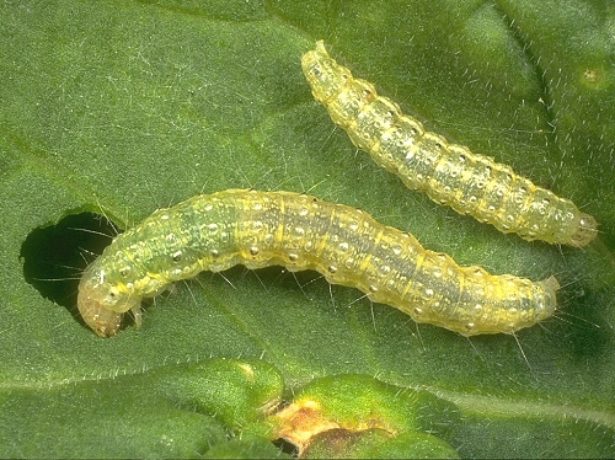

The caterpillar of the cabbage moth eats the young leaves
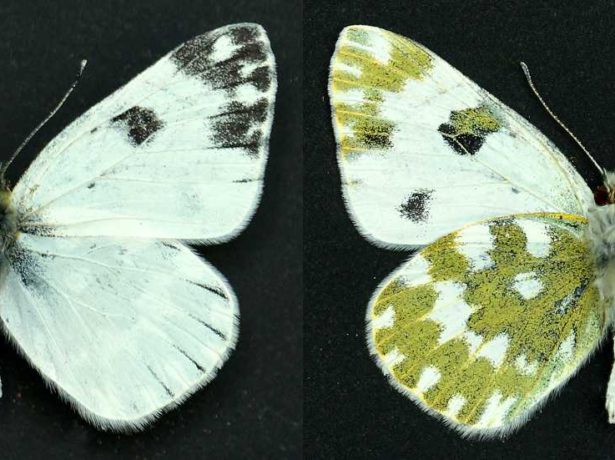

»Class =
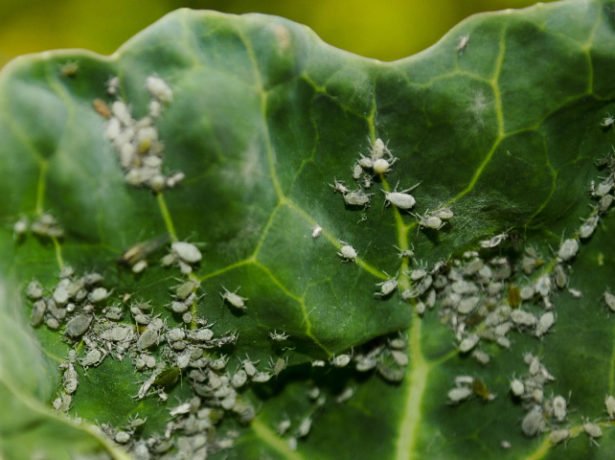

Aphids in whole colonies feed on cabbage
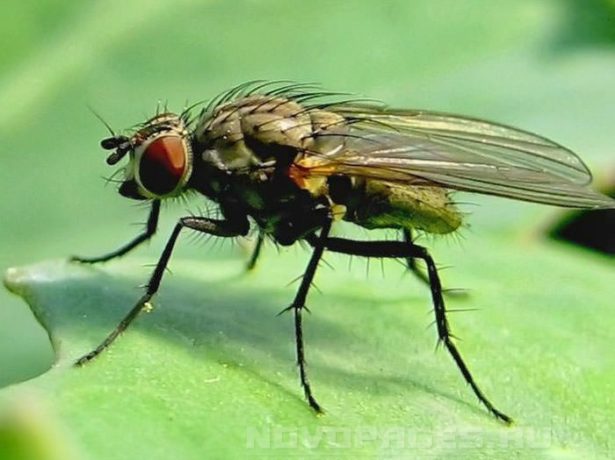

It is not the cabbage fly itself that is scary, but its larvae, gnawing at the roots.
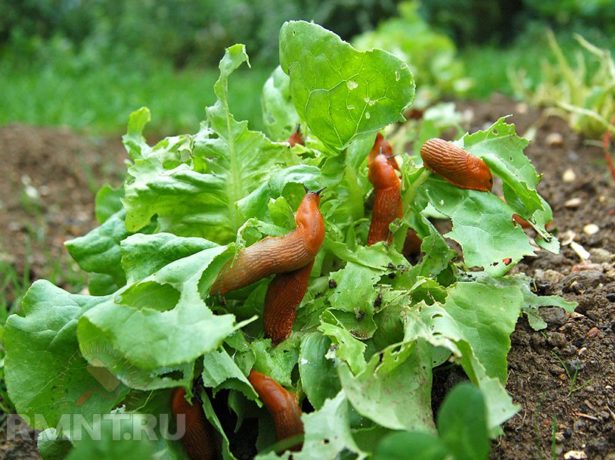

For slugs, your cabbage is both a table and a house
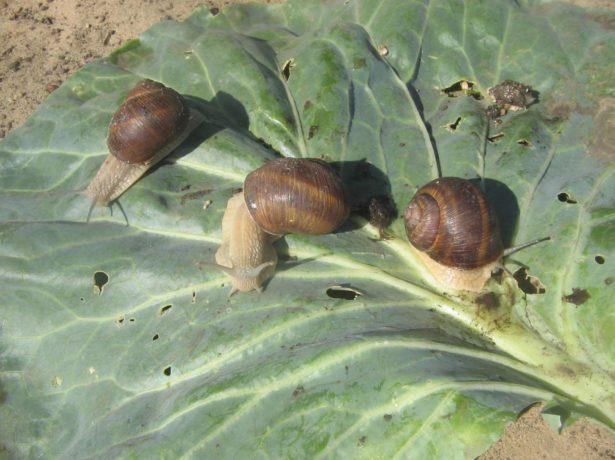

Cute snails can destroy huge amounts of cabbage
Video: how not to miss a pest on cabbage
Table: diseases characteristic of the Aggressor variety
| Diseases | Symptoms of the disease | Control methods |
| Keela (fungal disease) |
|
|
| Blackleg | The root collar and base of the stem first darken, then become watery and rot. |
|
| Mildew | Yellow spots form on the leaves, a gray bloom appears. | Treat the plants with a 1% solution of Bordeaux liquid (500 ml of the drug per 10 liters of water). |
Cabbage care
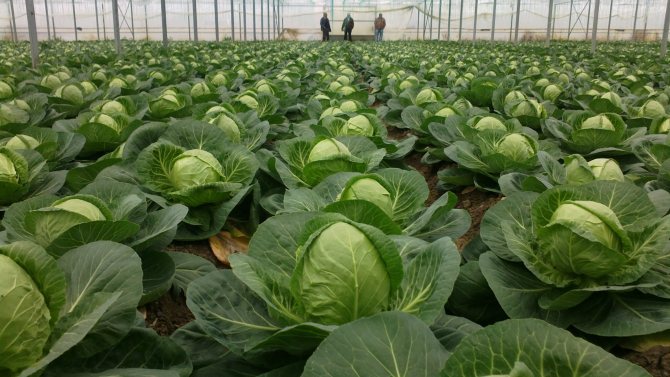

On the third day after planting, the leaves of the seedlings should be slightly powdered with ash. Thus, slugs and midges are scared away. Cabbage is not planted after radishes and rutabagas. And also this crop grows poorly on soils with high acidity. Vegetables are poured with warm water and only in the morning or evening.The soil is regularly weeded and hilled. To scare away insects, mint or marigolds are planted next to the cabbage. Harvesting is done at the end of September. From mid-September, watering and feeding are completely stopped.
Early varieties of white cabbage
Early cabbage varieties have the following characteristics:
- short ripening period (90-120 days from germination), the collection is carried out in June-July, when other varieties are still developing;
- herbaceous green leaves, very tender, juicy, ideal for salads, light summer cabbage soup;
- heads of cabbage are small or even small, often loose;
- low yield,
- not stored for a long time,
- plants are unpretentious, can grow in cramped conditions and on poor soils.
Usually, one bed of early cabbage is enough for seasonal consumption, on which it is not bad to organize a conveyor of ultra-early, early and medium-early.
Universal early varieties
Among the early varieties, a group of universal ones can be distinguished, which grow equally well in all regions of Russia. They are also the most suitable for the Far East, the south of Western Siberia, the Southern Urals and central Russia, including the Moscow region.
June
1967 variety from the VNIISSOK collection. The forks are very tight for an early variety. Cold-resistant, withstands early frost. Drought tolerant. Not prone to the formation of flower arrows. Heads of cabbage 1.0-2.5 kg, do not crack. The taste is delicate.
Number one Gribovsky 147
The oldest variety of 1937, bred by VNIISSOK, ripens 1-2 weeks later than June, so it is good to plant them together to extend the season of consumption. Round forks, less often oval, can crack. It tolerates a drop in temperature and drought normally. Heads weight 1.1-1.8 kg.
Number one Polar K 206
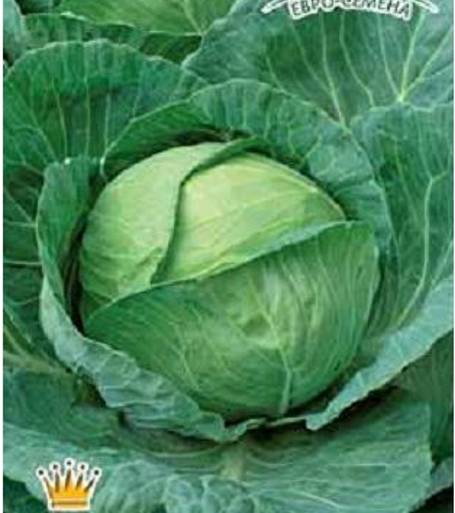

An old early variety, bred in 1937 on the basis of No. 1 Gribovsky. It ripens a week later than Gribovsky, is similar to him, but has a number of advantages:
- forms larger heads of cabbage weighing 1.9-2.8 kg,
- more yield (4.7-5.9 kg / m2),
- ripens at the same time, which allows to increase the period of consumption;
- when grown in the Far North, it is used for fermentation and storage fresh until January.
Cossack F1
This early hybrid, developed by the Krasnodar Rice Research Institute in 1994, has become very popular among summer residents and farmers over the past 20-plus years. Disease-resistant, cold-resistant, poorly tolerates temperatures above 25 degrees. Grows well in greenhouses. Heads of cabbage weighing 0.8-1.2 kg, leaves inside are yellowish-cream, do not crack. Yielding, reacts to fertilization with an increased size of the forks.
Golden hectare 1432
Medium-early, very productive (5.0-8.5 kg / m2) variety, bred by specialists from the Vavilov Institute in St. Petersburg. It is grown both in gardening associations and in large farms. The forks are medium in density, weighing 1.6-3.3 kg. Unpretentious, resistant to drought and shooting.
Early varieties for the North, Urals and Siberia
This group includes the best varieties of cabbage, developed by breeders specifically for regions with a short northern summer - the Middle and Northern Urals, Eastern Siberia, the north of the European part and Western Siberia.
Early ripening
An old early variety, bred by breeders of the Sortsemovosch association in 1968. In terms of ripening and taste, it is similar to June, but not so fruitful, heads of cabbage weigh only 900-1300 g. Cold-resistant, light- and moisture-loving. Grows well on peat bogs in the Leningrad region.
Arctic F1
Super early hybrid (90-97 days). Round forks weighing 1.0-1.5 kg. Cold resistant.
Junior F1
New, but already very popular mid-early hybrid from Syngenta. The State Register recommends growing this variety in the North-West, the Urals, the Volga-Vyatka region and Eastern Siberia. Not subject to fusarium wilting. Forks weighing 1.4-1.8 kg, taste good.
Breeding history
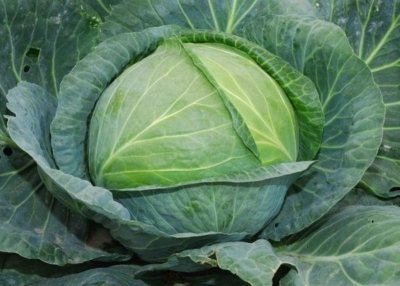

This the culture was sectioned in Holland in 2000. And in 2003 the Aggressor cabbage variety was included in the state register of our country.The variety is recommended for cultivation in the Central region of Russia. The "Aggressor" variety cabbage is grown:
- in the Central region;
- in the Kuban;
- in the Urals;
- in Siberia.
The name of the variety corresponds to the characteristics. The culture is immune to a number of diseases and pests, and is characterized by strong and accelerated growth.
The best varieties of white cabbage:
- Malachite. It is the earliest variety of white cabbage. Has small heads. The weight of one of them does not exceed two kilograms. Very juicy and spreading cabbage. The structure is moderately dense. The head of cabbage is hard. Grows well in temperate and warm climates. Loves frequent watering. Growing fast. If planted in a greenhouse, the growing season can be reduced to 5 days.
- Taurus F1. A popular early variety of white cabbage. Summer residents are very fond of growing it in their garden, since the fruits in a short period of time and subject to all the rules and principles of cultivation, reaches a weight of about 6 kg. Among the advantageous properties, it should be noted resistance to many diseases and pests. The growing season lasts up to 100 days. The Taurus F1 cabbage variety can be grown in temperate climates.
- Dobrovolskaya. One of the most productive, juicy and sweet varieties. The weight of one head can reach a record 8 kg. On average, fruits are harvested weighing 5 kg. belongs to the category of mid-season varieties of white cabbage. Mid-season cabbage is used for food and is intended for the preparation of many dishes. It is grown for sale by agricultural enterprises. Many varieties have good keeping properties. The uniqueness of the variety is that it is endowed with natural properties of protection against many diseases and pests. Thanks to this, the summer resident can count on high yields. The shelf life of Dobrovolskaya cabbage is almost six months (up to 5 months).
- Present. The vegetable is very tasty, juicy and nutritious, has a spicy zest. It is easy to recognize among other varieties, since the surface of the green leaves has a slight waxy coating. The weight of one fruit does not exceed 4 kg. The advantage of the Podarok variety is that it lends itself well to transportation without losing its shape. It is widely used for pickling and fermentation for the winter. Many are positioned as the best variety of medium-ripening white cabbage.
- Krautman F1. A hybrid variety, which has a dense fruit structure, weighing up to 5 kg., Has a small stump. Heads of cabbage do not crack even under abrupt changes in weather conditions. Delicious, pleasant vegetable is great for complex salting, preservation and fermentation. It is one of the kilo-resistant varieties of white cabbage.
- Geneva. Excellent late-ripening variety, ripening period - up to 140 days. One of the earliest among the late varieties. It has many advantages (good keeping quality, is not damaged during growth, has a dense structure, is transportable). Can be stored until a new harvest.
- Moscow late. Description of the Moscow late white cabbage variety will allow every summer resident to understand why it is one of the best. It is only necessary to announce the parameters of its heads of cabbage - they can reach a weight of 8-10 kg. The rosette at the head is large and rather spreading. The fruit has a rounded flat shape. It is resistant to many diseases, especially keel. A relatively frost-resistant variety that can withstand temperatures as low as 50C. Stores well until the next harvest. Heads of cabbage are dense, therefore they are easy to transport. This is the best late white cabbage. <
There are other varieties of this vegetable that are especially popular with summer residents and gardeners.Among them: early ones - Zarya, Dumas, Kazachok; middle - Slava 1305, Atria F1, Midor F1, Nadezhda, Belorusskaya 455, SB-3 F1, Merchant's wife; later - Amager, Creumont, Tyukriz.
Productivity and terms of harvesting heads of cabbage
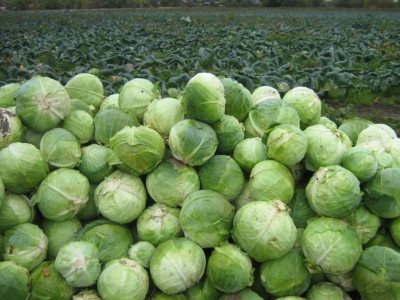

This cabbage variety has a record harvest: from 1 hectare on average get 431ts - 650c. In the Moscow region, a harvest of 800 centners per hectare was recorded.
Harvest cabbage variety "Aggressor" with the onset of the first cold weather, when the night temperature drops to 0 ° C, and the daytime temperature +10 + 12 ° C. This is the end of September or the beginning of October.
Heads of cabbage are cut off with a sharp knife. Leave a stump of 4 - 5 cm in size and 2 - 3 leaves to protect the head of cabbage from contamination.

